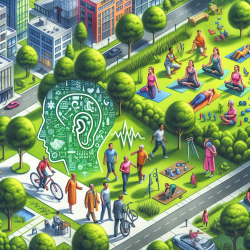Introduction
As a practitioner dedicated to enhancing children's outcomes through speech language pathology, understanding the broader environmental factors that influence health is crucial. The study "Neighborhood greenspace and health in a large urban center" provides valuable insights into how urban greenspaces, particularly street trees, can significantly impact health outcomes. This blog explores the findings of this research and offers guidance on how practitioners can leverage these insights to improve their practice.
Key Findings
The research conducted in Toronto, Canada, utilized high-resolution satellite imagery and individual tree data to examine the relationship between neighborhood greenspace and health. The study found that individuals living in areas with a higher density of street trees reported better health perceptions and fewer cardio-metabolic conditions. Specifically, having 10 more trees per city block improved health perception comparably to an increase in annual income of $10,000 or being 7 years younger. Similarly, 11 more trees per block were associated with a decrease in cardio-metabolic conditions equivalent to an income increase of $20,000 or being 1.4 years younger.
Implications for Practitioners
For practitioners in speech language pathology, these findings underscore the importance of considering environmental factors when assessing and planning interventions for children. Here are some practical steps practitioners can take:
- Advocate for Greenspace: Encourage schools and communities to increase street tree density, which could lead to improved health outcomes for children and their families.
- Incorporate Nature in Therapy: Utilize outdoor spaces with ample greenery for therapy sessions to potentially enhance cognitive and emotional well-being.
- Educate Families: Inform families about the benefits of greenspaces and encourage activities that involve exposure to natural environments.
Encouraging Further Research
While the study provides compelling evidence of the health benefits of street trees, it also highlights areas for further research. Practitioners are encouraged to explore the following:
- Longitudinal Studies: Conduct long-term studies to better understand the causal relationships between greenspace exposure and health outcomes.
- Specific Population Studies: Investigate how different demographics, such as children with specific speech and language disorders, may uniquely benefit from greenspaces.
- Mechanisms of Impact: Research the underlying mechanisms, such as stress reduction or improved air quality, that contribute to the health benefits of greenspaces.
Conclusion
The findings from the study on neighborhood greenspace and health offer a valuable perspective for practitioners aiming to improve health outcomes. By integrating these insights into practice and advocating for greener environments, practitioners can contribute to the overall well-being of children and their communities. For those interested in delving deeper into the research, the original paper can be accessed here: Neighborhood greenspace and health in a large urban center.










